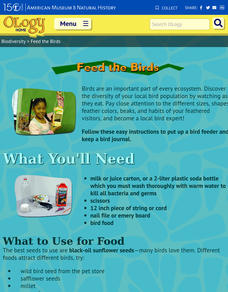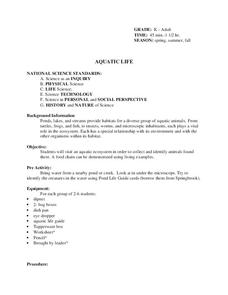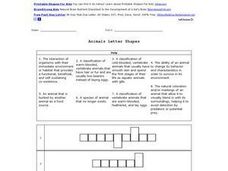University of Southern California
How do Organisms Interact?
Examine how organisms interact through a hands-on experience. Learners study population dynamics and distribution during an informative five-lesson unit. The focus is on the ocean environment and the organisms within it.
Curated OER
Bird Buffet
Fifth graders investigate how birds use their beaks. In this agriculture instructional activity, 5th graders use tools to simulate how birds gather food with their beaks. They then draw conclusions about certain types of beaks and what...
Pennsylvania Department of Education
Animal Classes and Their Ecosystems
Students explore animal characteristics by participating in an environment identification activity. In this animal habitat lesson, students discuss a range of different wild life and the ecosystems that they are a part of. Students view...
Curated OER
Animal Classification
Third graders differentiate between vertebrates and invertebrates, and identify the main characteristics of mammals, fish, reptiles, amphibians, and birds. They sort and categorize different types of balls, discuss the characteristics...
Curated OER
Finding Niches
In this niches worksheet, students will observe 2 different bird species around their home or school and complete a chart comparing the birds' food, home, habits, and description.
Curated OER
Mini-Ponds
In this mini pond worksheet, students create a mini-pond ecosystem with soil, water, and plant life. Students let their ecosystem sit for a day and they observe a sample the next day. Students identify all the pond water microorganisms...
Curated OER
Farm Animals
Why are farm animals important to the community? Expand young farmers' knowledge of furry and feathered friends through stories and a video. There are several books recommended; however, you could use any book about farm animals. A video...
American Museum of Natural History
Feed the Birds
What kinds of birds are common in the area? Young scientists use household supplies to create bird feeders. They then document the birds that come to their feeders by keeping journals.
Curated OER
Maple Syrup
Students explore maple syrup. For this natural resources lesson, students identify a maple tree in their neighborhood and observe the sap. Students sample maple products and create a graph of the taste-testing results.
Curated OER
Indoor Gardening
Young scholars determine how a plant grows best. For this botany lesson, students observe variables that affect plant growth. Young scholars explore how to grow and maintain a plant. Students make observations of their plant as it grows.
Curated OER
Kalahari Explorations
Students explore world geography by completing graphic organizers and researching the Internet. In this Kalahari desert lesson plan, students identify the geographic location, weather and creation of the Kalahari desert. Students define...
Curated OER
Teaching the Identification of Vegetables
Students engage in various activities designed to them that vegetables are an important part of a healthy diet.
Curated OER
Consumerism - Labeling Lab With Convenience Food
Students discuss the role of the consumer in the economy and the purpose of labels on products. In groups, they follow a recipe for a calzone using only pre-made dough, sauces and toppings. To end the lesson plan, they create their own...
Curated OER
Wacky Water Critters
Young scholars visit a local creek or stream. They collect water samples from the creek and observe and sort the "water critters" they find in the sample, observing smaller organisms under a microscope if necessary. They identify each...
Curated OER
What's That Habitat?
Fourth graders explore the environment by researching animal characteristics. In this habitat identification lesson, 4th graders utilize paper and crayons to illustrate their own habitats or homes and discuss what it contains that is...
Curated OER
Backyard Wildlife Conservation
Students survey local wildlife. They distinguish between permanent and migrating or seasonal species. Students identify species and describe the ecological niche. Students research the food chain and food web for the backyard...
Curated OER
Living and Non-Living
Students discover the basic needs of life. In this science lesson plan, students explore how all living things need air, water, food and shelter
Curated OER
Marshland Ecosystem
Students classify animals based on their physical characteristics and eating habits. In this animal identification lesson plan, students investigate the life forms shown on a Parisian ceramic basin, and discover ecosystem the artist was...
Curated OER
Aquatic Life
Students explore aquatic life. In this science lesson, students visit an aquatic ecosystem and collect animals found there. Students create a food chain for the aquatic ecosystem.
Curated OER
Holes, by Louis Sachar
Students use reading fluency, comprehension, vocabulary, written expression to write in journals as reading "Holes" by Louis Sachar. Some days are set aside for tests and/or food tasting.
Curated OER
Comparing Microscopic Organisms in Fresh and Polluted Water: An Invitation To Inquiry
Pupils have the opportunity to develop and formulate ideas and explanations through the scientific standard of inquiry. They identify organisms by using an identification key for specific aquatic geographical area.
Curated OER
For Creative Minds
Students study pictures of plants, animals, and minerals. Students classify the pictures into the three groups. For this rock identification lesson, students complete a rock finding lab experiment by finding, cleaning, identifying, and...
Curated OER
Animals Letter Shapes
Add some excitement to a basic life science activity by using this simple word puzzle! Scholars read 8 definitions and write the correct animal-related vocabulary word in the boxes provided. The boxes for each definition show the...
Curated OER
Scenario Introductory Menu Exercise
Seventh graders engage in a lesson that investigates the sources of Food Borne Illness. The practices of prevention are covered in the lesson. Various foods are looked at for the nutritional value and evaluated for the practices needed...

























